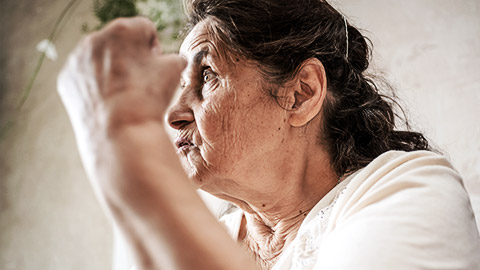In this section you will learn to:
- Use formal and informal methods to observe and monitor individuals
- Recognise situations for potential conflict and identify appropriate preventative and defusing strategies that can be employed
- Evaluate the person’s behaviour and interactions in a fair, objective and consistent manner
- Ensure decisions on action are consistent with available evidence and organisation policies
- Seek specialist advice and make necessary referrals
Supplementary materials relevant to this section:
- Reading A: The Impact of Unconscious Bias in Healthcare: How to Recognise and Mitigate it
- Reading B: Key Components of Shared Decision-Making Models: A Systemic Review
Previously, you were introduced to various behaviours of concern clients may present with and how to respond to them. In this module, you will learn about promoting and facilitating responsible behaviour through preventing and managing conflict. The module will cover an in-depth discussion on responding to aggression, violence, and suicidal ideation. Reporting requirements for incidents will also be covered.
We will begin this module on how workers may observe client behaviour. In this section, you will learn about various ways to observe client behaviour and recognise potential instances of conflict. This would allow workers to promptly implement strategies to prevent and minimise conflict.
Workers can use a range of formal and informal observation techniques to recognise potential instances of conflict. Formal observation techniques generally involve the use of standardised tools and data. On the other hand, informal observation techniques rely mostly on their expertise and intuition to assess and monitor the client’s well-being or mental state. Although formal observation techniques provide workers with more objective and measurable observations, informal observations have the benefit of allowing workers to promptly recognise changes in client behaviour.
The Healthcare Conflict Scale
The Healthcare Conflict Scale can be used as a tool that allows workers to monitor the severity of conflict (Fozbat et al., 2019). The scale measures 3 elements that contribute to conflict, which include contradicting communication, mistrust of motivations, and threatening language or actions.
The scale contains 7 items and takes approximately 2 minutes to complete. This allows workers to efficiently use the tool in fast-paced healthcare settings. Early warning signs of conflict are indicated by a score of 1 or 2, thus providing workers with an opportunity to prevent further escalation. Workers may use this scare during handovers as it allows workers to quickly communicate to others whether there is a potential for conflict.
See below for an example of the Healthcare Conflict Measure
| Please rate the following statements about the case Please score 1-10 for each item (1 = Strongly disagree; 10 = Strongly agree) |
Score | |
|---|---|---|
| 1 | The client and/or family say that the standard of care does not meet their expectation, e.g., symptoms not being optimally controlled | |
| 2 | The family perceive that resources are limiting standard of care | |
| 3 | The client and/or family do not trust clinical expertise and/or the healthcare system | |
| 4 | The client and/r family say that they are receiving contradictory or unclear advice from different staff members | |
| 5 | The client and/or family and staff members try to avoid each other | |
| 6 | The language used by staff members to describe client or medical situation has been perceived as insensitive or offensive by the client and/or family | |
| 7 | The client and/or family has been aggressive or has made physical or verbal threats (e.g., harm staff) | |
Routine Observation
Another characteristic of formal observation involves routine monitoring of client behaviour. Workers may observe clients at fixed schedules, such as every 30 minutes or every hour. More frequent observations may be required for clients who are at a high risk of harming themselves or others (Svensson, 2022).
Case Notes and Support Plans
Workers may refer to the client’s case notes to determine if changes in the client’s behaviour or risk for conflict escalation. Case notes may also provide information on the client’s history of conflict or aggressive behaviour. Information on the client’s triggers and previous support provided to defuse conflict may also be included.

Workers may use the acronym STAMP which helps to guide observation of non-verbal behaviour (Luck et al., 2007). Although the STAMP is not a formal behavioural checklist for observing client behaviour, it allows workers to quickly consider client behaviour in a comprehensive manner and notice any change in behaviour, and thus risk of aggressive or violent behaviour.
Starring: Workers may observe for prolonged staring from the client as it was found to be an indicator for aggressive behaviour or conflict.
Tone and volume of voice: In addition to louder volume of voice, workers should also consider the client’s tone of voice as an indicator for escalating conflict or aggression. For example, sharp, sarcastic, or demanding tones of voice may indicate potential conflict or aggression.
Anxiety: Workers should observe for anxious behaviour as high levels of anxiety suggest a higher risk of conflict and aggression. Common signs of anxiety include a flushed appearance, fast and short breath, rapid speech, and dilated pupils. Workers should also observe if clients are in pain. Physical indicators of pain include grimacing, writhing, and clutching one’s body.
Mumbling: Mumbling involves clients taking under their breath. In situations leading up to conflict or aggressive behaviour, clients may criticise staff members or the organisation softly or just loud enough to be heard by the worker.
Pacing: Workers should observe for pacing behaviour, which involves clients walking around confined areas such as waiting rooms or wards.
Case Study
Imagine that you are a health assistant at a clinic. A client approaches you and expresses that they wish to make a complaint against a staff member as she was unhappy about the standard or care provided to her. The client states that the staff member was rude to her and that she questions the decision made by the staff member. As the client explains her situation, you notice that she spoke anxiously and loudly. She is also making intense eye contact towards you.
Using both formal and informal observation methods, what are the possible signs of conflict in this scenario?

Workers should be aware of situations that may lead to potential conflict as this would allow them to engage in preventive and defusing strategies.
Ineffective communication
If not addressed promptly, ineffective communication between workers, clients, and clients' families or caregivers may lead to potential conflict. In healthcare settings, miscommunication surrounding the client’s care and support can lead to clients or their caregivers having differing expectations or disagreements about the support provided by the worker. This Healthcare Conflict Scale can also be used here to determine the reason for potential conflict as it details the various reason how the client or a client’s caregiver may have disagreements surrounding the client’s care.
Organisational factors
Stressful work environments because of inadequate staffing or resources, may lead to workers feeling fatigued or burnt out. This increases the risk of conflicts occurring as service delivery to clients is negatively impacted due to mistakes, poorer decision-making abilities, and poorer judgement.

Conflict Management Framework
The Conflict Management Framework aims to prevent and defuse conflict (Forbat & Barclay, 2019). This framework was found to be effective in helping healthcare workers identify and defuse conflict between workers and clients. The framework consists of two stages. In the first stage, focus is placed on preventing conflict where workers are prompted to be aware of conflict triggers. Workers should communicate this with one other through handovers or meetings and staff handovers between shifts.
The first stage of the framework also emphasises engaging with the client as soon as possible. This would involve addressing the clients concerns and reaching an agreement with the client, thus preventing escalation of conflict.
If conflict is not prevented in stage one, conflict is escalated, and stage two occurs. During stage two, it is recommended that workers consult their supervisors or managers. The security team or legal services may also be called upon if conflict escalates to aggressive or violent behaviour that threatens the safety of individuals.
Preventative and Defusing Strategies
In addition to recognising situations and triggers for conflict, patient-centred care should be practised, which involves understanding client concerns from the client’s point of view (Muddle et al., 2019). During situations for potential conflict, workers may explore the main reasons for the client’s concerns and practice shared decision making with the client when addressing concerns. Giving clients an opportunity to share their concerns in a supportive environment empowers the client, thus preventing potential conflict and improving client satisfaction.
Conflict can also be prevented by ensuring that there are adequate staff members and resources. Organisations should avoid lone workers and allow workers to access support from other staff members.
When unsure about whether a situation may lead to conflict or how conflict could be prevented, workers should be aware of the various supports available to them. A collaborative work environment where workers were able to consult and seek support from one another was found to help minimise the occurrence of conflict in healthcare settings (Almost et al., 2016). Instances of conflict were also reduced when there were opportunities for workers to voice their opinions and seek support from managers or supervisors (Almost et al., 2016).

Workers should ensure that they are evaluating client behaviour in a fair, objective, and consistent manner. This would involve minimising and addressing unconscious biases when evaluating client behaviour.
Unconscious bias refers to associations or attitudes that automatically influence an individual's behavior, interactions and decision making.
Unconscious bias refers to associations or attitudes that automatically influence an individual’s behaviour, interactions and decision making. For example, workers may have negative perceptions surrounding a person’s age, gender, and racial identity. This his could manifest as discrimination or unfair treatment against clients (Marcelin et al., 2019).
If a worker notices that they have unintentionally behaved in a discriminatory manner, he or she should acknowledge their actions and be responsible for the consequences. Workers should also distinguish between the intent and impact of action. This refers to workers considering and rectifying the impact of the bias rather than focusing whether the bias had occurred. Workers should reach out to the client and rebuild trust. It is important for the worker to have an open discussion with co-workers or their supervisor about the interaction that occurred and discuss how bias can be prevented in the future.
To reduce biases in work settings, workers may also rely on the previously discussed formal observation methods to help minimise biases. Workers are also encouraged to practise self-reflection. Workers should first consider how their personal identity and experiences may influence their interactions with clients.
The following diagram illustrates how workers can manage biases through self-reflection before and after they occur:
|
We all have bias... |
||
|---|---|---|
| While you cannot control another's actions, you can be an example to others with your own: | ||
|
Be Aware Of your biases and how such biases appear as "intuition" |
Be Systematic By using concrete guidelines or checklists, be transparent in decision-making |
Be Open To new experiences and to learning about different identities |
| What if I unintentionally commit microaggressions? | |
|---|---|
| Intent vs Impact |
|
| Own Your Actions |
|
| Reinforces and Repair |
|
Self Reflection
Consider your personal values and beliefs surrounding how conflict should be resolved. How do you think this may influence the way you observe for signs of conflict?
Reading
Reading A: The Impact of Unconscious Bias in Healthcare: How to Recognise and Mitigate it
This reading provides further information on unconscious bias presents itself in healthcare settings. It also provides information for both workers and organisations on how they may recognise and minimise the unconscious bias that could interfere with service delivery.

Shared Decision-Making
The Shared Decision-Making Model can assist workers with making decisions based on all available evidence. In line with patient-centred care, the model highlights the need for workers to consider clients as an important source of evidence as clients are the experts of what matters most to them (Bomhof-Roordink et al., 2019).
The model suggests that workers should consider multiple elements when making decisions. It encourages workers to gather information from the client in a deliberate manner that considers the client’s preferences. Then, workers can create choice awareness and describe the available options to the client. As clients may be unfamiliar with shared decision making and may feel overwhelmed with choices, workers should provide a brief description of the process (Hoffman et al., 2014). This involves explaining what the model entails and providing reassurance that support will provide throughout the decision-process.
After inviting the client to the shared decision-making process, workers may start with asking clients if they have a preferred actions that they might want to take and expectations. Workers may then weight up the pros and cons of each action together with the client in the context of the client’s preferences and values. When finalising on the client’s preferred action, the worker should check with the client to ensure that they are ready to make the decision without further information from the client. Further discussion may be needed to ensure that the client is making an informed decision about their care. Hence, this ensures that workers are making decisions that are in line with information or evidence provided by the client.
Reading
Reading B: Key Components of Shared Decision-Making Models: A Systemic Review
This reading provides an overview of what the common factors shared between shared decision-making models within the healthcare sector.
Following Organisation Policies
Workers should also ensure that decisions made are in line with organisation policies that outline how workers should prevent conflict. Organisation policies generally outline steps workers can take to prevent and defuse conflict. In addition to this, organisation policies outline the various expectations, roles, and responsibilities of workers. Understanding the expectations, roles and responsibilities ensures that workers are making decisions within their scope of practice. Furthermore, having an outline of the various roles as stated on organisation policies provide workers information on the relevant staff members that need to be informed and staff members that they can seek further support from.
In addition to colleagues and the manager, workers may also consider seeking support from specialist services and make the necessary referrals when the client’s concerns go beyond scope of practice. Referrals can be made to other allied health services that meet the client’s needs. If unclear about the specific services required to support the client, referrals can also be made to a general practitioner. This is in line with the Code of Conduct of allied health professionals highlighting the need to refer clients to a general practitioner where appropriate (Allied Health Professions Australia, 2018).
When seeking advice or making referrals, workers should ensure that they are providing sufficient information about the client and obtaining informed consent from the client on sharing information with other services.
When marking a referral or seeking advice from another professional, the following information should be communicated:
- Patient details: Patient details should include the patient identifiers such as the name, date of birth, or contact information. Relevant medical or health information should also be included. This includes information such as medical history or current medications.
- Reason for referral: The reason as to why the client has been referred should be clearly stated and communicated. Information on the client’s needs and issues should be included to ensure continuous care and support for the client.
- Referrer information: Workers should provide information about their role and the scope of the care they have provided to the client. If the worker is continuing to provide care and support to the client, this should also be stated.
- Relevant client documentation: Other relevant documentation such as client records, notes, or their support plan may also be included during the referral process to ensure a comprehensive understanding of the client’s needs. To protect the client’s confidentiality, workers should follow the organisation’s policies and procedures when sharing client information with other specialists or professionals.
This section of the module provided you with various tools and information needed to observe client behaviour in a way that is objective, thus minimising individual bias. This section also highlights the importance of recognising the early signs of conflict and conflict prevention strategies that emphasise the need for shared decision-making to fully consider the client’s needs and concerns.
- Allied Health Professions Australia. (2018). MBS Review Position Statement - Direct Referrals - Allied Health Professions Australia. Allied Health Professions Australia -. https://ahpa.com.au/advocacy/mbs-review-position-statement-direct-referrals/
- Almost, J., Wolff, A. C., Stewart-Pyne, A., McCormick, L. G., Strachan, D., & D’Souza, C. (2016). Managing and mitigating conflict in healthcare teams: an integrative review. Journal of Advanced Nursing, 72(7), 1490–1505. https://doi.org/10.1111/jan.12903
- Bomhof-Roordink, H., Gärtner, F. R., Stiggelbout, A. M., & Pieterse, A. H. (2019). Key components of shared decision making models: a systematic review. BMJ Open, 9(12). http://dx.doi.org/10.1136/bmjopen-2019-031763
- Forbat, L., & Barclay, S. (2019). Reducing healthcare conflict: Outcomes from using the conflict management framework. British Medical Journal, 104(4), 328-332. https://doi.org/10.1136/archdischild-2018-315647
- Fozbat, L., Mnatzaganian, G., & Barclay, S. (2019). The Healthcare Conflict Scale: development, validation and reliability testing of a tool for use across clinical settings. Journal of Interprofessional Care, 33(6), 680-688.
- Hoffman, T. C., Légaré, F., Simmons, M. B., McNamara, K., McCaffery, K., Trevena, L. J., Hudson, B., Glasziou, P. P., & Del Mar, C. B. (2014). Shared decision making: what do clinicians need to know and why should they bother? The Medical Journal of Australia, 201(1), 35-39. https://doi.org/10.5694/mja14.00002
- Luck, L., Jackson, D., & Usher, K. (2007). STAMP: components of observable behaviour that indicate potential for patient violence in emergency departments. Journal of Advanced Nursing, 59(1), 11-19. https://doi.org/10.1111/j.1365-2648.2007.04308.x
- Marcelin, J. R., Siraj, D. S., Victor, R., Kotadia, S., & Maldonado, Y. A. (2019). The impact of unconscious bias in healthcare: How to recognise and mitigate it. The Journal of Infectious Disease, 220(S2), S62–S73. https://doi.org/10.1093/infdis/jiz214
- Muddle, L., O'Malley, C. J., & Stupans, I. (2019). Learning and teaching of patient-centred communication skills in allied healthcare manual therapy students: A systematic review, 32, 21-27. https://doi.org/10.1016/j.ijosm.2019.04.002
- NYC Office Suites. (2018). [Photo of people sitting at a desk and two are shaking hands while the third smiles]. https://nycofficesuites.com/2018/12/18/how-to-manage-conflict-in-the-workplace-and-prevent-conflict-among-coworkers/
